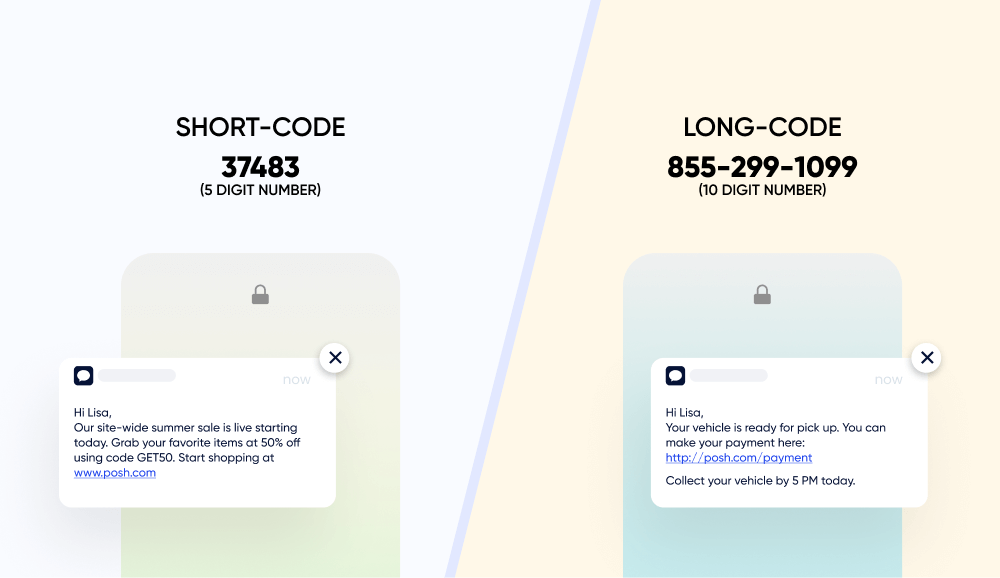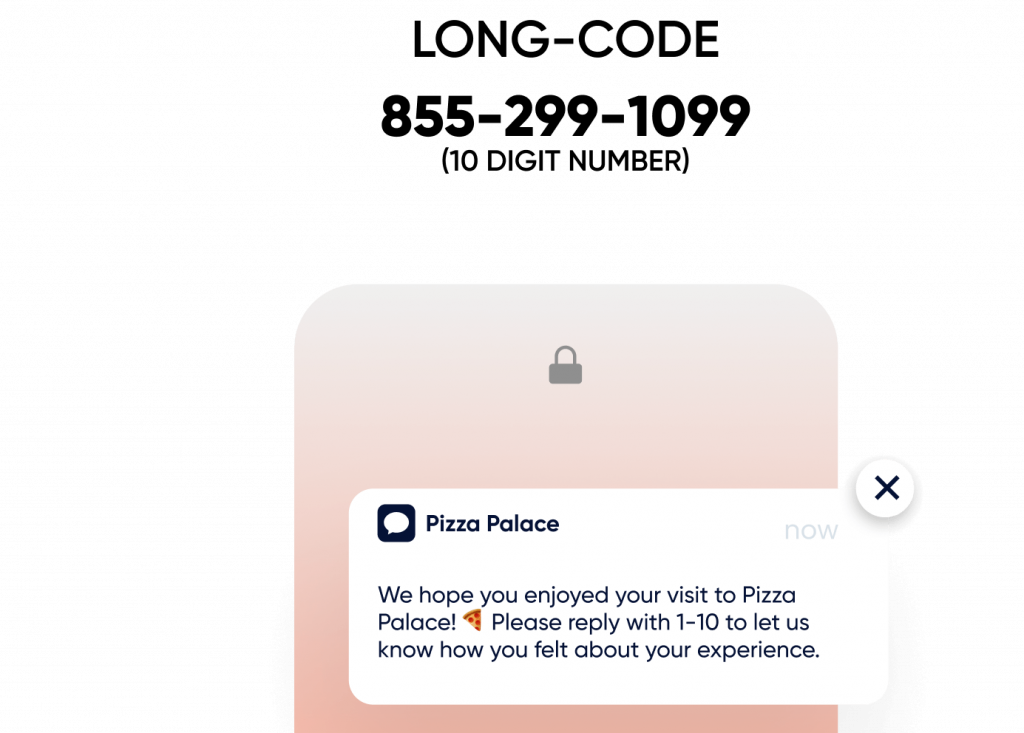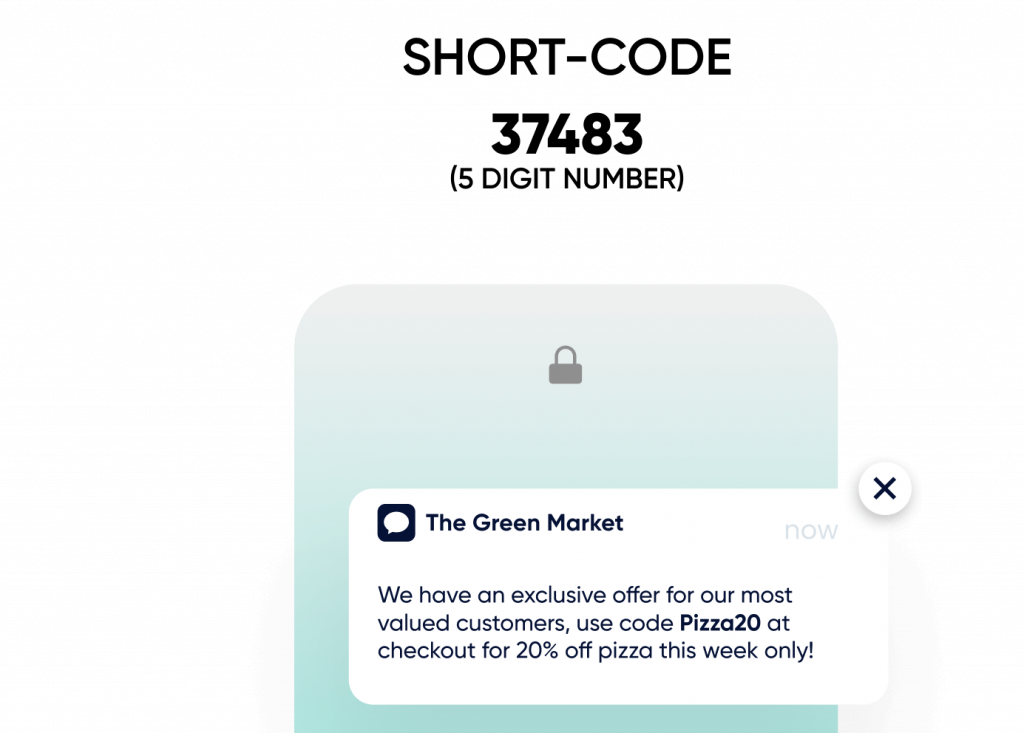SMS long code vs. short code: Which is right for your business?
SMS marketing has emerged as a powerful customer engagement tool for businesses—it’s no surprise that marketing teams are tapping into the 98% open rates.
Updated on 10 Oct 2025
Getting started with SMS marketing can be confusing. For instance, where do you start when choosing between short and long codes? Especially when the number you pick could be the difference between success and failure with your SMS campaigns.
This blog explores the differences between long codes and short codes. It delves into the advantages and disadvantages of each type of SMS marketing number, before discussing which option could be best for your business needs, and the best way to start SMS marketing.

SMS long codes explained
An SMS long code (toll-free or 10DLC) is a long phone number with either a country or local code, and can be used for SMS marketing.
Depending on your location, SMS long codes can take two forms:
- Toll-free numbers: Toll-free numbers are indicated by specific prefixes. In most countries, this takes the form of 0800 or 800. If you already own a toll-free number, you can text-enable it through your chosen SMS marketing provider. While you can start texting from your toll-free number upon upgrading to a paid account, your sending capabilities may be limited until the number is verified with wireless carriers. Your SMS marketing provider will guide you through the verification process.
- Local numbers (10-digit long codes or 10DLC): US businesses also have the option of local number texting, also known as 10DLC—a more recent player in the marketing SMS field. With the same capabilities of short code numbers, it allows businesses to send a large volume of SMS campaigns using a local area code.
You can text-enable your existing local number, with calls functioning as usual while texts are routed to your chosen SMS marketing platform. Businesses often prefer local numbers because they have recognizable area codes that instill trust, they are approved for high-volume bulk SMS, and setting up a local number is typically quick and cost-effective.

Due to familiarity with the number, long codes can be better for creating a personalized and human approach. This makes them ideal for customer support, appointment reminders, or survey requests. A business choosing a long-code phone number should also know that long code can both send and receive phone calls, while short code is exclusively for SMS.
Another major advantage of long codes is how easy they are to set up. Long codes are easier and quicker to obtain than short codes. This accessibility makes them a great cost-effective solution for small businesses or those with limited budgets.
Toll-free numbers do allow for bulk messaging, making them suitable for businesses that need to communicate with customers more frequently. However, they’re subject to throughput limits, meaning you can only send a limited number of messages per minute per code. Because of this, they may not work for large-scale campaigns involving high message volumes.
Check out our SMS software product tours
How to get started with long codes
To get started with long code, you’ll need to choose one of the following methods:
- P2P (person-to-person) messaging: Businesses directly communicate with customers one-on-one. This approach allows for personalized interactions, however, it cannot be automated and is not recommended for most businesses.
- Toll-free texting: Enables businesses to use a dedicated toll-free number to send SMS messages to customers. This not only provides a professional touch but also makes it convenient for recipients to engage, as it’s free to send and receive texts. However, it’s not compatible with high-volume messaging.
- A2P (application-to-person): Businesses use specialized platforms or software applications to send SMS messages to customers. This approach allows for scalability and is extremely efficient, with most SMS platforms enabling messages to be part of wider cross-channel journeys.
- A2P 10DLC: For US businesses, using an application to send messages from a 10DLC number can be a happy middle ground for businesses looking to send a variety of marketing messages without the price tag of a short code number.
For most businesses, it’s a priority to find an SMS platform that can automate the process and include SMS into a wider journey orchestration to help nurture new and returning customers.
⭐⭐⭐⭐⭐
“SMS marketing with Insider has exceeded all of our expectations. Our only regret is not using it sooner. Our conversion rates have skyrocketed, and the combination of SMS with other channels has made customers more responsive than ever.”
- VP of Marketing | Global pizza delivery brand
Short codes
As the name suggests, short codes are shorter than long codes. They’re usually five to six digits in length, and are specifically designed for high-volume, mass messaging. This makes them ideal for many marketing campaigns and promotions.
There are two main types of short codes: shared and dedicated. Shared short codes are literally that: codes that multiple businesses use at the same time. Each business receives a unique keyword they use to identify their campaign.
Why would any business want to share a short code? Because they’re more cost-effective. The businesses sharing the code also share the cost. As you might expect, however, this comes with limitations in terms of availability. There’s also a risk of keyword conflicts if multiple businesses in the same industry use the same code.
Dedicated short codes offer a higher level of control and customization. A business has complete ownership over these codes, helping to ensure brand consistency. While dedicated short codes are more expensive, they’re more reliable and eliminate the risk of keyword conflicts.
Advantages of short codes
Short codes offer several advantages over long codes that make them an attractive option for many organizations:
- High throughput: Short codes have a higher throughput rate compared to long codes. Businesses can send a large number of messages in a short period, making them ideal for mass marketing campaigns and time-sensitive promotions.
- Memorable and recognizable: Short codes provide a memorable and easily recognizable number that allows customers to quickly identify the sender. This can improve brand recall and increase customer engagement.
- Opt-in subscriptions: Short codes are often used for opt-in subscriptions, where customers can subscribe to receive updates, promotions, or exclusive content from a business. This facilitates targeted marketing and can help build a loyal customer base.
- Branding opportunities: Businesses can add their branding to dedicated short codes, allowing for consistency across multiple channels.
- National and international reach: With short codes, businesses can run campaigns at the national or even international level, enabling them to reach the widest possible audience quickly. They can also be used in different geographies with few limitations, offering great flexibility.
- Legal compliance is built in: Short codes are designed to ensure compliance with anti-spam laws and protect customers from unsolicited messages, providing peace of mind and convenience for brands, who can rest assured that compliance is already taken care of.

Long code or short code: which is best for you?
There’s a lot of info out there on the different types of SMS code. To make things easier, here are four key factors to consider when deciding between long codes and short codes:
- Campaign objectives: If you plan to run mass marketing campaigns, require high throughput, and want a memorable number, go for short codes. They are well-suited for promotions, opt-in subscriptions, and time-sensitive offers. If you want more focused, smaller-scale campaigns or direct communication that allows for meaningful engagement and feedback with a high level of personalization, go for long codes.
- Budget: Long codes are more cost-effective and best for businesses with limited budgets. Short codes cost more, requiring a separate application process and ongoing fees. They’re better suited for large enterprises or businesses with substantial marketing budgets, or large scale campaigns where the ROI will justify the higher costs.
- Campaign size and reach: If you need localized numbers for regional or country-specific campaigns, long codes are great. For national or international campaigns with a larger target audience, short codes will give you that scalability and reach.
- Message volume: High-volume campaigns need short codes, which are designed to handle such loads efficiently. Long codes have throughput limitations, so are better suited to less time-sensitive and smaller scale messaging.
⭐⭐⭐⭐⭐
“For such an extensive platform, Insider has made learning the tool incredibly easy. After joining for Architect, its cross-channel journey builder, we decided to add SMS to our marketing channels and have been wowed by the results. We have consistent open rates of 96%, and SMS has increased our CVR by 8%.
- Marketing Director | Fashion retailer
Getting started with short codes
To get started with short code SMS, you’ll first need to apply for an SMS short code and register with an SMS marketing platform.
While short code SMS is the most expensive option, for large businesses the investment will be worth it. The easy-to-remember nature of short codes makes them ideal for additional marketing campaigns, and if you’re using SMS as part of a wider cross-channel strategy, the unlimited sending capability means your customers will never miss out.
The right choice depends on your needs
By now you should have a clearer understanding of the difference between SMS long and short codes, and why you would choose one over the other. By considering your budget, campaign objectives, and target audience, you can make an informed decision that will increase your chances of success.
Insider’s SMS marketing platform
Design personalized, contextual, and timely SMS messages using A2P in the Insider platform. Keep your customers engaged and show users the value your brand brings to their lives every day on their favorite device.
Book a demo with one of our experts to learn more about how Insider can transform your marketing campaigns with SMS.



















